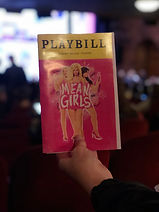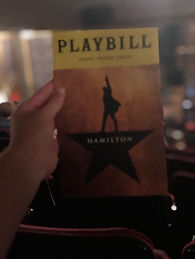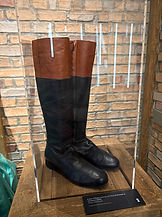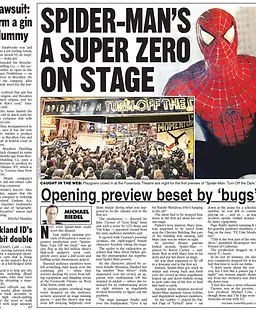top of page


The 2010s
Diversity, Social Media, & Modern Innovation



The 2010s were a decade full of rapid technological change, the expansion of social media, and a growing cultural emphasis on activism, identity, and inclusion. Platforms like Instagram, Twitter (X), and Musically (Tiktok) once again changed how people shared and consumed media, including Broadway. This digital revolution coincided with a greater cultural emphasis on identity, activism, and inclusion, as movements like #MeToo and Black Lives Matter came into the forefront of the news.
Broadway musicals began to reflect the 2010’s demand for representation and creativity. The decade saw “More focus… paid to diversity and highlighting underrepresented voices…”(Houston Symphony, 2023). This shift helped Broadway connect and engage with a broader audience. Shows like Dear Evan Hansen, which explored mental health through a modern pop-indie sound, reflected this blend of innovation and relevance.
Theaters embraced a wide range of music, and plotlines. As the Houston Symphony notes, the era “…featured a variety of blockbuster shows pulled from a multitude of styles and genres. This showcased how diverse fans of musical theatre have become thanks to worldwide exposure earned on social media” (Houston Symphony, 2023).
This variety of musical styles not only attracted Broadway fans but also captivated a younger, more global audience. The widespread use of social media helped Broadway musicals gain fans through the formation of dedicated fan bases that could share clips, create creative fan art, edits, memes, reactions, and generate massive word-of-mouth buzz. This furthered musical’s popularity far beyond New York, bringing Broadway to new global heights.





One of the most successful and defining Broadway musicals of the 2010s was Hamilton, an artistically and commercially revolutionary (literally) production, with music, lyrics and book by Lin Manuel Miranda. It tells the story of Alexander Hamilton, a poor Caribbean immigrant who became a founding father through hip-hop and R&B style music, and a racially diverse cast. The musical traces his journey through the American Revolution, fleshing out his relationships, drama, scandals, and rivalries, most notably with Aaron Burr who is responsible for Hamilton's tragic death in a duel.
By Portraying this history through Lin Manuel’s innovation, Hamilton reimagined who gets to live, die, and tell America’s story. As critic Ruthie Fierberg explains, “Hamilton, changed the reputation of musicals on a global scale. With its combination of influences from musical theatre and hip hop, Hamilton's score appealed first to listeners-who have turned into audiences-of all tastes, ages, ethnicities, countries of origin.... Any boundary that can be broken has” (Fierberg, 2019).
Its success was not just limited to the stage, Hamilton became a cultural phenomenon. The original cast recording went multi-platinum, won a Grammy, and topped streaming charts. It also won 11 Tony Awards, a Pulitzer Prize for Drama, and received international acclaim. What made the show even more impactful was how it humanized historical figures and made the American Revolution feel personal and culturally relevant.
“The characters and themes of Hamilton are also highly relatable. The founding fathers are not portrayed as distant historical figures but as flawed, complex individuals, who are also ambitious, passionate, and all too human. The struggles they face, their dreams and disappointments, their triumphs and failures are experiences that audiences can identify with…” (The Broadway Collection, 2023).
This emotional depth, combined with the show’s cultural relevance, allowed Hamilton to resonate with new generations of theatergoers, many of whom felt represented. Beyond Broadway, Hamilton fostered a large online fan community. Miranada’s social media is extremely active and he often hosts campaigns supporting User-generated-content (UGC) like Hamilton costume contests.
Additionally, Hamilton’s social media regularly follows internet trends, and began a #Ham4Ham campaign, a series of live mini-performances outside the Richard Rodgers Theatre. This blew up online and allowed fans worldwide to participate in the Broadway experience. Their Ham4Ham ticket lottery also allowed the show to be more financially accessible. It has continued to creatively draw back audiences, most recently with Leslie Odom Jr., who originated the role of Aaron Burr, returning to Hamilton for a limited engagement.
An icon of the 2010s (and today), Hamilton reflected the decade’s broader narratives, making it not just a hit musical but a defining moment in modern theater history.

"WE KNOW WHAT THESE PEOPLE LOOK LIKE–THEY’RE ON OUR MONEY; THEY’RE ON STATUES. OUR GOAL WAS TO TAKE THEM OFF OF THE STATUES AND OFF OF THE MONEY AND MESS WITH THEM A LITTLE BIT."- LIN-MANUEL MIRANDA



One of the 2010s, or perhaps one of Broadway history’s most infamous failures, was Spider-Man: Turn Off the Dark. Despite its promising elements of fan-favorite Spider-Man, music by U2’s Bono and The Edge, and direction by Julie Taymor (The Lion King), the production became a cautionary tale. From its inception, the musical faced numerous challenges. The production utilized complex aerial stunts, which led to multiple accidents during previews, notably actor Chris Tierney suffering a 30-foot fall due to a harness malfunction.
“During the show’s previews, several actors were injured in accidents, which forced the producers to delay the official opening of the show. These incidents not only caused harm to the cast and crew but also contributed to the negative buzz surrounding the production” (Theatre Haus, 2023).
In fact, the mishaps became so well-known that they were parodied on Saturday Night Live and on the front cover of The New Yorker. Financially, the musical was unprecedented in its scale with a $75 million budget, the most expensive in Broadway history.
Despite moments where it topped box office charts (mostly due to tourism), the large running costs meant that the show was consistently operating at a loss. As reported, “Spider-Man spent the majority of its lifespan among the top sellers on Broadway, although running costs were so sky-high that not much coin could make it back into the recoupment pot” (Cox, 2013).
Creative differences further affected the production. Director Julie Taymor’s original vision, which incorporated mythology into the traditional Spider-Man narrative, was met with criticism, and eventually Taymor was replaced. Additionally, Bono and The Edge had no prior experience with Broadway musicals, leaving the production’s songs unmemorable.
Ultimately, Spider-Man: Turn Off the Dark closed in January 2014, having incurred an estimated loss of $60 million. Another reminder that despite the fact that “Everybody loves a hero,” even the most promising concepts and a brilliant team can implode on the Broadway stage.
bottom of page

